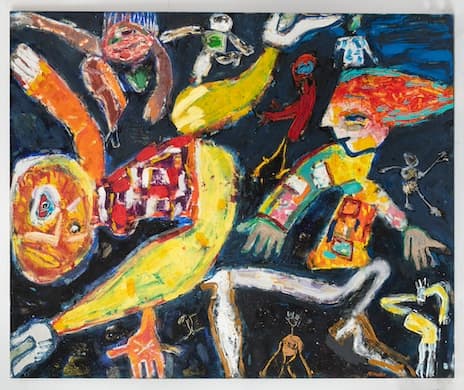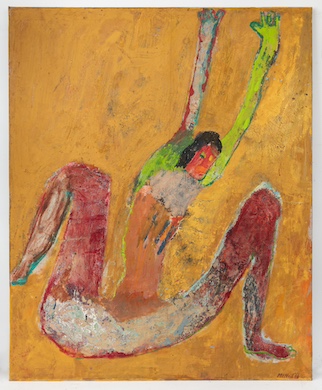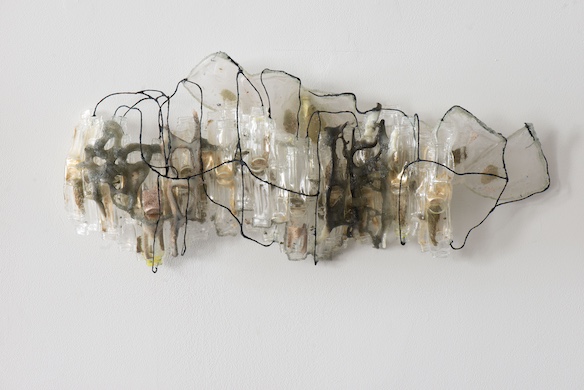Works of George McNeil, an Underappreciated Hometown Boy, Highlight a Healthy Gallery Season
We should be grateful to commercial venues like Picture Theory for picking up the slack for MoMA, the Met, and the Whitney. Also on display and worth viewing are works by Nancy Cohen and Olive Ayhens.

‘Estate of George McNeil: Discos and Dancers’
Picture Theory, 548 W. 28th St., Suite 238
Until May 11
‘Nancy Cohen: The State We’re In’
Kathryn Markel Fine Art, 179 Tenth Ave.
Until May 4
‘Olive Ayhens: Metabolic Metropolis’
Bookstein Projects, 39 E. 78th St., 4th Floor
Until April 12
Here’s a question that passed through my mind as I visited Picture Theory, a newish exhibition space at Chelsea: Would George McNeil (1908-95) have stooped to posting his paintings and prints on Instagram? I say “stooped” because of the animus McNeil had for self-promotion. This was the man who bowed out of Nina Leen’s renowned portrait of The New York School, “The Irascibles,” a photo that did much to cement its primacy in the public eye.
Think about it: The Mount Rushmore of Abstract Expressionism — Jackson Pollock, Willem de Kooning, Mark Rothko, and … George McNeil? There are myriad reasons an artist’s reputation does or doesn’t scale the heights. Personality is one of them; cultural cache is another. McNeil bristled when his individuality was put under duress: no team player, he. Still, McNeil’s peers held the work in high esteem — de Kooning was a fan — and scratched their collective head at his lack of notoriety.
McNeil’s art found an audience in the mid-1980s. His late canvases — rambunctious meldings of AbEx facture and graffiti-influenced pictograms — benefited from a renewed interest in both Expressionism and figurative painting. Given the buoyant and often uproarious nature of the compositions, not a few observers thought McNeil had finally achieved maturity at the ripe old age of 70-something. “As George McNeil gets older,” a former New York Times critic, Michael Brenson, wrote, “his work gets younger.”

“Discos and Dancers,” the current exhibition of McNeil’s art at Picture Theory, puts that theory to test. Among the most striking paintings in the show, “Occasion” (1966), predates McNeil’s popular heyday by a good two decades. Its melding of ArtBrut imagery with a Bonnard-like color palette may have been fobbed off at the time as not being sufficiently innovative. Yet McNeil was less interested in the outre than in the primal. He was painting for the long game. That, and the overriding subject of his work is joy. In the end, maybe McNeil wasn’t irascible enough.
McNeil’s pictures have not gone unnoticed by our cultural institutions. The work is included in the collections of MoMA, the Met, and the Whitney — where, for the most part, it has been gathering dust in the storage racks. You’d think our hometown institutions would want to celebrate a hometown boy, particularly given how much the paintings were inspired by our local music scene. Punks, disco dollies, and headbangers, oh my.
There is, alas, no accounting for the vagaries of museological fashion. We should be grateful to commercial venues like Picture Theory for picking up the slack.

The work of sculptor Nancy Cohen has invariably and, perhaps ineluctably, embodied fragility: employing glass and paper, mediums highly susceptible to human touch, all but guarantees as much. Yet if the title of her current exhibition at Kathryn Markel Fine Arts, “The State We’re In,” acknowledges a world in flux, the pieces themselves are more particular in emphasis and more interior in effect.
Freestanding amalgamations of glass and wire, sometimes inflected with pigment, are endowed with a counterintuitive sensitivity of flesh; encompassing wall pieces shaped with pulped paper bring to mind radiographs or microscopic events. All the while Ms. Cohen juxtaposes her materials with quiet aplomb and fetching tactility. Here is an unassuming and deeply felt art.
“The aesthetics of pollution” is the stated subject of a show at Bookstein Projects, “Olive Ayhens: Metabolic Metropolis.” Spanning almost 30 years, this array of oil paintings and watercolors showcases an artist of deeply held convictions and unapologetic eccentricity. Her teetering vistas of “urban strata” can be whimsical in character: “From Empire State” (2002) channels Paul Klee and Saul Steinberg to lighthearted effect. Yet Ms. Ayhens also has the capacity to unnerve.
What to make, for instance, of the abrupt mash-up of modernist architecture, divergent landscapes, and frogs — lots of frogs — in “Amphibian Emergency” (2008)? A current of environmental alarm is both amplified and mitigated by Ms. Ayhens’ knack for the telling detail, her nudgy brushwork, and a consummate deployment of warm and cool tonalities.
Heir to the American strain of idiosyncratic visionaries, Ms. Ayhens is a link in a chain that includes Albert Pinkham Ryder, Louis Eilshemius and Florine Stettheimer. That’s not bad company to keep. Ms. Ayhens’ art is unstoppable.

